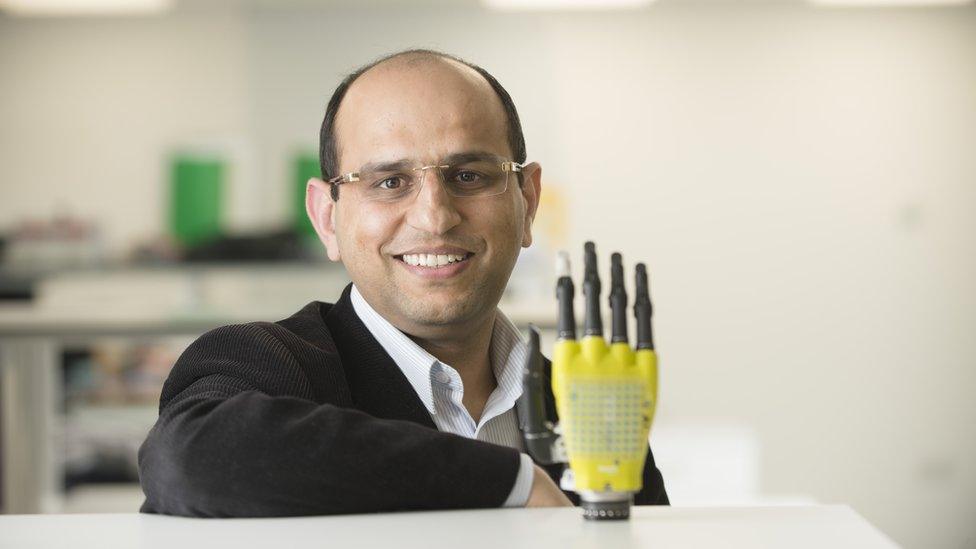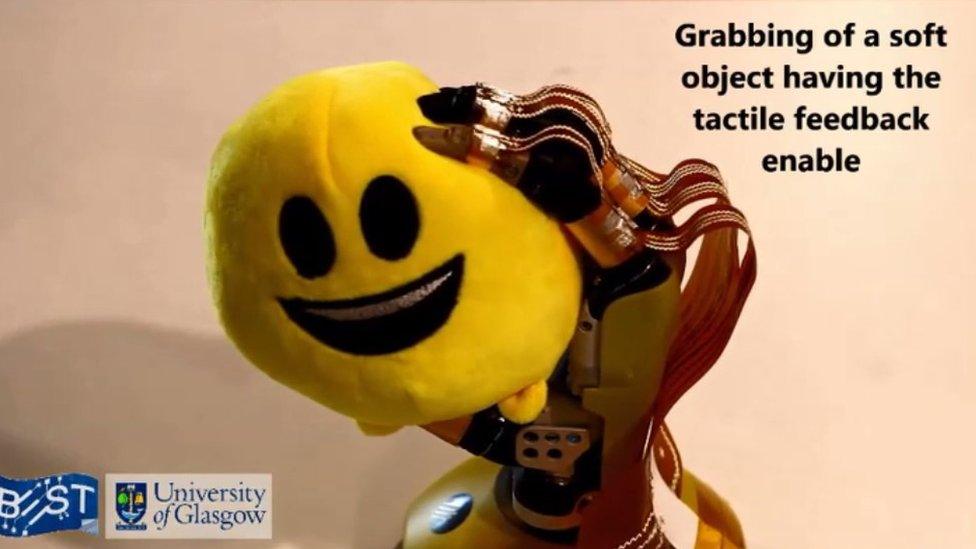Solar-powered skin for prosthetic limbs
- Published

Dr Ravinder Dahiya has developed the skin for prosthetic hands
A synthetic skin for prosthetics limbs that can generate its own energy from solar power has been developed by engineers from Glasgow University.
Researchers had already created an 'electronic skin' for prosthetic hands made with new super-material graphene.
The new skin was much more sensitive to touch but needed a power source to operate its sensors.
Previously this required a battery but the latest breakthrough has integrated photo-voltaic cells in to the skin.
Gripping materials
Dr Ravinder Dahiya, from the University of Glasgow School of Engineering, said: "The real challenge was 'how can we put skin on top of photo-voltaic and yet allow light to pass through the skin?' That's what we have done."
The skin uses graphene, which is about one million times thinner than paper and is currently the world's strongest material.
Its optical transparency allows about 98% of the light that strikes its surface to pass directly through it making it ideal for gathering energy from the sun to generate power.
Dr Dahiya said: "Human skin is an incredibly complex system capable of detecting pressure, temperature and texture through an array of neural sensors which carry signals from the skin to the brain."
He said the researchers had made significant steps in creating prosthetic prototypes with synthetic skin that were capable of making very sensitive pressure measurements.

He said this meant prosthetic limbs could have a much a better sense of touch, temperature and texture.
Dr Dahiya said: "When the skin is placed on a prosthetic hand and the amputee then touches an object they are able to feel the contact pressure as well as temperature."
He said the addition of a solar power capability meant there would be no need for an external battery to power the skin's sensors.
The doctor said: "It is a skin that can generate its own energy, the power needed to operate it.
"This from prosthetic point of view leads to a skin that lets an amputee feel plus, without any additional battery, the prosthetic limb will be lighter."
He said: "We are trying to bring the weight closer to the normal human hand. There is still a long way to go."
The new skin requires just 20 nanowatts of power per square centimetre.
Dr Dahiya said the skin had easily generated more power than it needed but it was currently not possible to store the energy.
He said the team were already looking at ways to divert unused energy into batteries, allowing it to be used when required.
Eventually, the doctor hopes to power the prosthetic limb's motors with the renewable energy as well - rather than just the skin.
Dr Dahiya added: "The other next step for us is to further develop the power-generation technology which underpins this research and use it to power the motors which drive the prosthetic hand itself.
"This could allow the creation of an entirely energy-autonomous prosthetic limb.
"We've already made some encouraging progress in this direction and we're looking forward to presenting those results soon."
The technology could also increase the functionality of robots, allowing them to have a better understanding of what they touch and interact with, according to Dr Dahiya.
If robots had limbs that were sensitive to touch and pressure they would be less likely to make errors or injure humans, he said.
The researchers hope to further develop the prototype in the next two years.
The team's paper, Energy Autonomous Flexible and Transparent Tactile Skin, is published in Advanced Functional Materials.